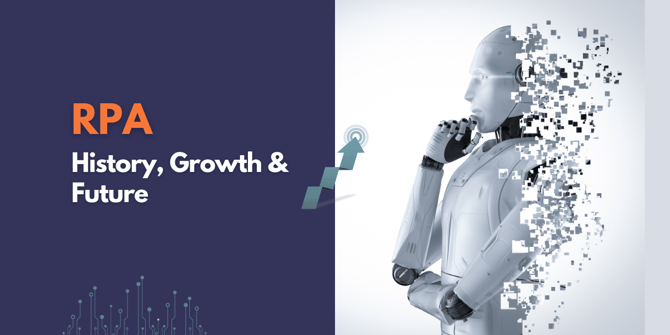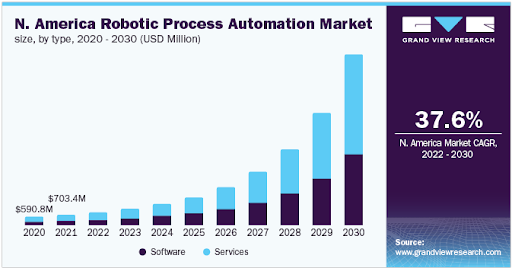RPA History, Growth and Future
This article provides a concise overview of the history, growth, and future prospects of Robotic Process Automation (RPA). It explores the evolution of RPA, its current status in terms of growth, and offers insights into its anticipated developments

Did you know while reading this blog, some processes are getting automated using Robotics Process Automation services?
- Are you curious to know where it all started?
- How has RPA evolved?
- Is it a fad or a wham?
Here, this article will address all these questions. Also, it provides you with in-depth insights to use RPA accordingly for your organization.
Early RPA – From Where It All Started
The most frequently asked question is, “Did RPA exist long ago under the umbrella of traditional automation?”
Let’s uncover the answer!
Though the term Robotic Process Automation emerged in the initial years of 2000, it had its primary developments after the 1990s. The early chapter of RPA tells that it had three to four key predecessors which were Screen Scraping software, Desktop Macros, Workflow Automation and Management tools, and lastly, Artificial Intelligence.
RPA still relies on these technologies but has uplifted the precision in the process and has exceptionally improved its capability to increase the quality of deliverables to the users.
The Evolution of RPA – Unskippable Benchmarks

Undeniably, RPA’s growth has witnessed an unprecedented rise in the last few years. And its impacts are higher than you could have thought.
So, when businesses and organizations look for ways to maximize efficiency, RPA slides in as the answer. To leverage big profits and thrive in today’s competitive market, organizations look for experienced RPA developers to implement RPA in their workflow across different verticals.
Since RPA implies automation of the workflow using drag-and-drop features without relying on the code, the proliferation of RPA was exceptionally easy. And the best part is people can easily adopt and use RPA even if they are rookies to robotic process automation.
Simply put, RPA has reached a potential where the software robots have the capability to work round the clock without needing any human intervention.
“Unsurprisingly, IT automation has the fastest adoption to RPA and penetrated globally into the market.”
Considering Finance and Accounting, the notion of “craftsmen” work has reached unparalleled levels of productivity and precision compared to the traditional ways. The only difference that occurs with human work is eliminated and made consistently efficient through RPA.
To put it all together, RPA in finance has started swapping the data entry and the data rekeying jobs with its automated software robots and techniques. Also, it’s anticipated that in the future, no data entry, rekeying, and other repetitive, monotonous tasks will be done manually. Approximately all of the protocol and rule-driven tasks can be automated easily through RPA.
What the Expert Predicts for its Future
Having an in-depth understanding of the evolution of RPA sheds light on the innovation of the wider industries from which it was initiated. And its exceptional rise clearly shows that the thirst for advancement will continue as technology grows.
As a result, experts predicted numerous effects that this may have on the present technology and its uses.
Greater Adoption of RPA
Nowadays, businesses are aware of the benefits of RPA and what competitive edge is offered by integrating it into their businesses.
In the last few years, the impact of RPA has already become exceptionally significant as it inclined from being used primarily in multinational companies with larger budgets to the realm of national, mid-cap, and also smaller businesses. As this trend continues, Robotics Process Automation services seem to be adopted by more and more companies to integrate through a wider array of processes.
Stepping Into More Domains
With RPA becoming more mainstream, more RPA use cases are getting popular. And, as the technology expands into a wider variety of industries, including the ones with significant power like banking, financial services and retail, law, oil and gas, insurance sector, and manufacturing industries.
Advancements in RPAs External Process Potential
With advancements in technology, more organizations are constantly trying RPA and witnessing results from it. As a result, most businesses are being motivated to try their hands with the software’s capabilities – in simpler terms, this is making the segment primed for innovations and new applications soon emerging.
Though, with RPA presently focusing on internal business processes, it’s better to consider that as innovation happens, developments take place in what RPA can do for external processes.
Internal Processes Capabilities Will Again Rise
RPA will certainly maintain its core focus on internal processes.
For example, incoming email classification is an area that is already massively improving with the help of RPA. In the coming years, most computer-related processes that are managed with a set of protocols will be handled with the help of RPA as well as analytics and data analysis.
Compatibility with Other Tools
Soon, it will be common to see RPA used in compliance with other workplace tools. As companies increasingly adopt RPA into their processes, it becomes clear that it works best when integrated with other tools that they use.
Eventually, this results in RPA being used more in conjunction with other work management platforms.
SPA is Going To Be The New Constant
SPA – Smart Process Automation is coined as the next evolution of RPA.
The RPA deployed in most companies and organizations today faces challenges to automate unstructured data, but SPA will blend Machine Learning, Artificial Intelligence, Big Data, and Cloud technology to extract data from unstructured sources and process it contextually with more intelligent rules.
Bigger AI Capabilities
Artificial Intelligence and Robotic Process Automation are intrinsically related through their shared history.
So, it’s no more a surprise that the next phase of RPA is expected to consist of greater incorporation with AI as Robotic Process Automation steps far away from being simply a rule-based technology.
Finally, Is RPA Future Bright?
In the coming years, with advancements of RPA getting fully evolved, all those operations that a human does will be automated by RPA.
These platforms will address the unforeseen errors and exceptions in the business process and will learn and adapt based on their previous experiences and actions. Despite conventional automation, they can also apply judgment and creativity to their work, allowing companies to automate enhanced visibility, collaboration, transparency across the value chain.
Thus, it’s right to say that there will be a widespread adoption of RPA across different fields. And, if you are planning to ride the bandwagon, partnering with a trusted RPA consulting service is the first step to a promising future.
After all, RPA can spark a wider cultural change that has increased flexibility, success and satisfaction.














